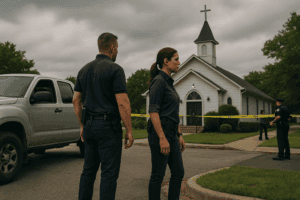Ensuring the safety and security of students and staff requires a proactive approach.
Conducting comprehensive risk assessments is the cornerstone of any effective school security plan.
These evaluations identify vulnerabilities, prioritize improvements, and lay the foundation for a safe learning environment.
What is a Risk Assessment?
A risk assessment is a detailed process that evaluates a school’s physical security, policies, and emergency response capabilities.
By identifying gaps and vulnerabilities, schools can implement targeted improvements that reduce the likelihood and impact of threats.
Key Objectives of Risk Assessments:
- Evaluate current security measures, such as access control and surveillance.
- Identify vulnerabilities in physical infrastructure, like entry points and windows.
- Assess preparedness for various scenarios, including natural disasters and active threats.
Why Are Risk Assessments Critical?
1. Identifying Vulnerabilities
Risk assessments provide a clear picture of weak points in a school’s security.
For example, an assessment might reveal unsecured entry points or insufficient surveillance coverage.
Addressing these issues proactively can prevent potential threats from escalating.
2. Prioritizing Security Improvements
Not all vulnerabilities require the same level of attention. Risk assessments help prioritize actions based on likelihood and impact, hopefully ensuring resources are allocated effectively.
3. Enhancing Emergency Preparedness
A well-conducted risk assessment evaluates how prepared the school is for emergencies. This includes reviewing evacuation routes, communication plans, and staff training programs.
4. Reducing Liability Risks
By conducting regular assessments, schools demonstrate a commitment to safety. This can reduce liability and provide peace of mind to parents, staff, and the community.
Steps in a Comprehensive Risk Assessment
1. Physical Security Review
Evaluate key areas like perimeter fencing, doors, and windows. Assess whether measures like shatter-resistant film or access control systems are in place.
2. Policy and Procedure Evaluation
Review existing safety protocols, including lockdown procedures and visitor management policies. Ensure they align with best practices and state requirements.
3. Threat Analysis
Analyze potential threats, from natural disasters to active shooter situations. This includes understanding the specific risks unique to the school’s location.
4. Staff and Student Preparedness
Assess training programs and drills to ensure staff and students are familiar with emergency procedures.
5. Collaboration with Experts
Work with external experts to gain an objective perspective. Companies like Risk Strategy Group provide professional assessments tailored to your school’s needs.
Real-World Example: Lessons from Uvalde
The tragic incident at Robb Elementary highlighted the importance of conducting regular risk assessments.
According to the Robb Committee Report, insufficient communication systems and overlooked vulnerabilities contributed to delays in response.
A comprehensive risk assessment may have identified these gaps beforehand.
How Risk Strategy Group Can Help
At Risk Strategy Group, we specialize in helping schools create safer environments through detailed risk assessments. Our services include:
- Evaluating physical and procedural security.
- Identifying vulnerabilities and providing actionable recommendations.
- Assisting with compliance to meet state and federal safety best practices.
Take Action Today
Conducting a risk assessment isn’t just about meeting standards—it’s about protecting what matters most. Proactively addressing vulnerabilities can save lives, reduce liabilities, and foster a culture of safety.
Ready to get started? Contact Risk Strategy Group for expert guidance and tailored solutions.






